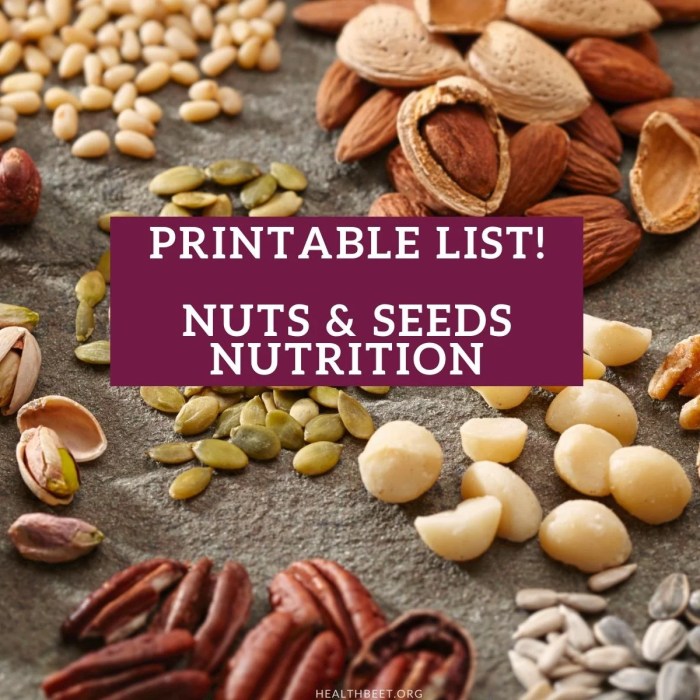
Nuts and seeds are often overlooked as nutritional powerhouses, but their small size packs a mighty punch of health benefits. From boosting heart health to regulating blood sugar, these tiny treasures offer a wealth of vitamins, minerals, and essential fatty acids that can significantly enhance your overall well-being.
This comprehensive guide delves into the fascinating world of nuts and seeds, exploring their nutritional value, different types, and creative ways to incorporate them into your daily diet. We’ll uncover the secrets behind their unique flavor profiles and textures, discuss considerations for allergies and dietary restrictions, and even explore their potential in the food industry and culinary world.
Nutritional Benefits of Nuts and Seeds
Nuts and seeds are nutrient-packed powerhouses that offer a wide array of health benefits. They are excellent sources of essential vitamins, minerals, healthy fats, and fiber, making them valuable additions to a balanced diet.
Macronutrient Profile
Nuts and seeds provide a balanced mix of macronutrients, including protein, fat, and carbohydrates. The specific macronutrient composition varies depending on the type of nut or seed.
- Protein: Nuts and seeds are good sources of protein, which is essential for building and repairing tissues, producing enzymes and hormones, and supporting immune function. For example, almonds, cashews, and pumpkin seeds are particularly rich in protein.
- Fat: Nuts and seeds are primarily composed of healthy fats, including monounsaturated and polyunsaturated fats. These fats play crucial roles in heart health, brain function, and hormone production. For example, walnuts are known for their high content of omega-3 fatty acids, which are beneficial for heart health.
- Carbohydrates: While nuts and seeds are not high in carbohydrates, they do contain some complex carbohydrates, which provide sustained energy. These carbohydrates are often fiber-rich, contributing to digestive health.
Micronutrient Profile
Nuts and seeds are packed with a variety of micronutrients, including vitamins and minerals, which play essential roles in maintaining overall health and well-being.
- Vitamins: Nuts and seeds are rich in vitamins, such as vitamin E, which is an antioxidant that protects cells from damage, and vitamin B, which is essential for energy production and nerve function. For example, sunflower seeds are a good source of vitamin E, while almonds are rich in vitamin B2.
- Minerals: Nuts and seeds are also excellent sources of minerals, including magnesium, which is crucial for muscle function and nerve health, and zinc, which is important for immune function and wound healing. For example, pumpkin seeds are a good source of zinc, while cashews are rich in magnesium.
Health Benefits of Nuts and Seeds
Consuming nuts and seeds regularly can have a positive impact on various aspects of health, including heart health, blood sugar regulation, and weight management.
Heart Health
Nuts and seeds are known for their heart-healthy properties. Their high content of monounsaturated and polyunsaturated fats, fiber, and antioxidants helps lower cholesterol levels, reduce blood pressure, and improve blood vessel function.
- Lowering Cholesterol: The monounsaturated and polyunsaturated fats in nuts and seeds can help lower LDL (bad) cholesterol levels, which are linked to an increased risk of heart disease.
- Reducing Blood Pressure: The potassium and magnesium found in nuts and seeds can help relax blood vessels, reducing blood pressure.
- Improving Blood Vessel Function: The antioxidants in nuts and seeds help protect blood vessels from damage, improving blood flow and reducing the risk of heart disease.
Blood Sugar Regulation
Nuts and seeds can help regulate blood sugar levels. Their high fiber content slows down the absorption of sugar into the bloodstream, preventing spikes and crashes in blood sugar levels.
- Slowing Sugar Absorption: The fiber in nuts and seeds acts like a sponge, slowing down the absorption of sugar from the digestive tract.
- Improving Insulin Sensitivity: Some nuts and seeds, such as almonds, have been shown to improve insulin sensitivity, which helps the body use glucose more efficiently.
Weight Management
Nuts and seeds can be beneficial for weight management. Their high protein and fiber content can help promote satiety, reducing hunger and cravings.
- Promoting Satiety: The protein and fiber in nuts and seeds help you feel full for longer, reducing the urge to overeat.
- Reducing Calorie Intake: Nuts and seeds are relatively calorie-dense, but their high nutrient content can help you feel satisfied with smaller portions.
Examples of Nuts and Seeds and Their Nutritional Profiles
Different types of nuts and seeds offer unique nutritional profiles. Here are some examples:
| Nut/Seed | Key Nutrients | Health Benefits |
|---|---|---|
| Almonds | Protein, vitamin E, magnesium, fiber | Heart health, blood sugar regulation, weight management |
| Cashews | Protein, magnesium, zinc, fiber | Bone health, immune function, nerve function |
| Walnuts | Omega-3 fatty acids, protein, fiber, antioxidants | Brain health, heart health, inflammation reduction |
| Sunflower seeds | Vitamin E, selenium, magnesium, fiber | Antioxidant protection, immune function, nerve function |
| Pumpkin seeds | Zinc, magnesium, fiber, antioxidants | Immune function, prostate health, sleep improvement |
Types of Nuts and Seeds

Nuts and seeds are highly nutritious and versatile additions to a healthy diet. They offer a range of essential nutrients, including healthy fats, protein, fiber, and vitamins and minerals. To understand the diversity of nuts and seeds, it’s helpful to categorize them based on their botanical origins and characteristics.
Categorization of Nuts and Seeds
Nuts and seeds can be broadly categorized into three main groups: tree nuts, legumes, and seeds.
- Tree nuts are the edible seeds of trees. They are typically encased in a hard shell. Examples include almonds, walnuts, pecans, and cashews.
- Legumes are the seeds of plants in the Fabaceae family. They are often called “pulses” when dried and used as food. Examples include peanuts, soybeans, and lentils.
- Seeds are the reproductive parts of plants. They can be derived from various plant parts, including fruits, vegetables, and flowers. Examples include sunflower seeds, pumpkin seeds, chia seeds, and flaxseeds.
Common Nuts and Seeds
There are many types of nuts and seeds available, each with its unique flavor profile and texture. Here is a table highlighting some of the most common varieties:
| Type | Name | Flavor Profile | Texture |
|---|---|---|---|
| Tree Nut | Almond (Prunus dulcis) | Mild, slightly sweet | Crisp, slightly chewy |
| Tree Nut | Walnut (Juglans regia) | Rich, earthy, slightly bitter | Firm, slightly oily |
| Tree Nut | Pecan (Carya illinoinensis) | Sweet, buttery | Crisp, slightly brittle |
| Tree Nut | Cashew (Anacardium occidentale) | Mild, slightly sweet | Creamy, slightly chewy |
| Legume | Peanut (Arachis hypogaea) | Mild, slightly sweet | Crisp, slightly oily |
| Legume | Soybean (Glycine max) | Mild, slightly nutty | Firm, slightly chewy |
| Seed | Sunflower Seed (Helianthus annuus) | Mild, slightly nutty | Crisp, slightly oily |
| Seed | Pumpkin Seed (Cucurbita pepo) | Mild, slightly nutty | Crisp, slightly oily |
| Seed | Chia Seed (Salvia hispanica) | Mild, slightly earthy | Slightly crunchy, gelatinous when soaked |
| Seed | Flaxseed (Linum usitatissimum) | Mild, slightly nutty | Slightly crunchy, slightly oily |
Incorporating Nuts and Seeds into Your Diet

Adding nuts and seeds to your diet is a delicious and easy way to boost your intake of essential nutrients. These tiny powerhouses are packed with healthy fats, protein, fiber, vitamins, and minerals that can benefit your overall health.
Creative Ways to Incorporate Nuts and Seeds
Incorporating nuts and seeds into your diet doesn’t have to be complicated. Here are some creative and practical ways to enjoy them:
- Snacking: A handful of mixed nuts or seeds is a satisfying and nutritious snack. Try adding a sprinkle of pumpkin seeds or sunflower seeds to your yogurt or oatmeal.
- Breakfast: Top your morning toast with almond butter or sprinkle chia seeds on your smoothie. Add a handful of walnuts to your breakfast cereal or granola.
- Lunch: Add a sprinkle of hemp seeds or flax seeds to your salad. Make a nut-based pesto for pasta or sandwiches.
- Dinner: Roast vegetables with a sprinkle of chopped walnuts or pecans. Add a handful of sunflower seeds to your stir-fry or quinoa salad.
- Baking: Substitute some of the flour in your favorite recipes with almond flour or ground flaxseed. Add chopped nuts or seeds to your cookies, muffins, or bread.
Sample Meal Plan Incorporating Nuts and Seeds
Here is a sample meal plan that demonstrates how to incorporate nuts and seeds into your daily diet:
- Breakfast: Oatmeal with berries, a sprinkle of chia seeds, and a handful of almonds.
- Lunch: Salad with grilled chicken or tofu, a handful of sunflower seeds, and a light vinaigrette dressing.
- Dinner: Salmon with roasted vegetables, a sprinkle of chopped walnuts, and a side of brown rice.
- Snacks: A handful of mixed nuts, a small bowl of trail mix, or a smoothie with almond butter and flaxseed.
Storing Nuts and Seeds Properly
To maintain the freshness and nutritional value of nuts and seeds, it’s important to store them properly.
- Refrigerate: Store nuts and seeds in an airtight container in the refrigerator to prevent them from going rancid. This method is particularly recommended for oil-rich nuts like walnuts and almonds.
- Freezing: For longer storage, you can freeze nuts and seeds in airtight containers or freezer bags. This can help to extend their shelf life for several months.
- Avoid Moisture: Keep nuts and seeds away from moisture, as this can lead to mold growth.
- Check for Spoilage: Regularly inspect nuts and seeds for signs of spoilage, such as discoloration, rancidity, or mold growth. Discard any spoiled nuts or seeds.
Considerations for Allergies and Dietary Restrictions
While nuts and seeds offer a wealth of health benefits, it’s crucial to be aware of potential allergies and dietary restrictions. Certain individuals may experience severe reactions to these ingredients, highlighting the importance of careful consideration.
Identifying Potential Allergens
Food labels provide essential information for individuals with allergies. Carefully reviewing ingredients lists is paramount to ensure the absence of common nut and seed allergens.
- Common Nut Allergens: Peanuts, tree nuts (almonds, walnuts, cashews, pecans, pistachios, hazelnuts, macadamia nuts, Brazil nuts), and others.
- Common Seed Allergens: Sesame seeds, sunflower seeds, and poppy seeds.
It’s also essential to be mindful of potential cross-contamination in food preparation. Even trace amounts of allergens can trigger reactions in sensitive individuals.
Alternative Ingredients for Nut and Seed Allergies
For those with nut or seed allergies, a range of alternative ingredients can provide similar flavors and textures:
- Pumpkin Seeds: A good substitute for sunflower seeds, offering a similar nutty flavor.
- Hemp Seeds: Can replace sesame seeds in some recipes, providing a mild, nutty taste.
- Sunflower Seed Butter: A delicious alternative to peanut butter, offering a similar creamy texture.
- Tahini: A sesame seed paste, can be substituted with sunflower seed butter for those with sesame allergies.
Always consult with a healthcare professional or registered dietitian for personalized dietary recommendations and to discuss any concerns related to allergies or dietary restrictions.
Food and Related Products
Nuts and seeds are not only nutritious snacks but also versatile ingredients that play a significant role in the food industry. Their unique flavors, textures, and nutritional profiles make them valuable additions to a wide range of food products.
Potential of Nuts and Seeds in the Food Industry
The food industry has recognized the potential of nuts and seeds, leading to their widespread use in various food products. This trend is driven by consumer demand for healthier and more natural options.
Processing and Incorporation of Nuts and Seeds
Nuts and seeds can be processed and incorporated into food products in various ways, depending on the desired outcome. Common processing methods include:
- Roasting: Roasting enhances the flavor and texture of nuts and seeds, making them more palatable and easier to digest.
- Grinding: Grinding nuts and seeds into nut butters, flours, or pastes allows for their inclusion in various recipes, adding nutritional value and unique flavor profiles.
- Extraction: Extracting oils from nuts and seeds produces valuable cooking oils and ingredients for cosmetics and other industries.
- Chopping: Chopping nuts and seeds into smaller pieces adds texture and flavor to granola bars, trail mixes, and other snack foods.
Examples of Food Products Containing Nuts and Seeds
| Product | Type of Nut/Seed | Processing Method | Benefits |
|---|---|---|---|
| Almond Butter | Almonds | Grinding | High in protein, healthy fats, and vitamin E |
| Sunflower Seed Oil | Sunflower Seeds | Extraction | Rich in vitamin E, linoleic acid, and oleic acid |
| Granola Bars | Various Nuts and Seeds | Chopping, Roasting | Provides a good source of fiber, protein, and healthy fats |
| Trail Mix | Various Nuts and Seeds | Chopping, Roasting | Convenient and portable snack, rich in nutrients |
Product Creation
The potential for innovative food products using nuts and seeds as primary ingredients is vast. By leveraging the nutritional and flavor profiles of these ingredients, new products can cater to a wide range of dietary needs and preferences.
Concept for a New Food Product
This concept introduces a line of nut and seed-based snack bars targeted at health-conscious consumers seeking convenient, nutritious, and flavorful options. The product will be called “Seed & Nut Power Bars.”
Detailed Description
The Seed & Nut Power Bars are crafted with a blend of roasted nuts and seeds, combined with natural sweeteners and wholesome ingredients like dried fruit, oats, and chia seeds. The bars are designed to provide a balanced source of protein, fiber, healthy fats, and essential vitamins and minerals.
Target Audience
The target audience for Seed & Nut Power Bars encompasses individuals seeking:
- Convenient and portable snack options
- Nutritious and energy-boosting snacks
- Plant-based and vegan-friendly options
- Gluten-free and allergy-friendly alternatives
Unique Selling Proposition
The unique selling proposition (USP) of Seed & Nut Power Bars lies in their:
- High-quality, natural ingredients
- Balanced nutritional profile
- Variety of flavors and textures
- Commitment to sustainability and ethical sourcing
Potential Market and Competitive Landscape
The market for snack bars is highly competitive, with established brands dominating the space. However, there is a growing demand for healthier and more natural snack options. Seed & Nut Power Bars will differentiate themselves by focusing on:
- Using premium nuts and seeds as primary ingredients
- Offering a wider range of flavors and textures than traditional snack bars
- Emphasizing transparency in sourcing and production practices
The product will be positioned as a premium alternative to existing snack bars, appealing to consumers who prioritize health, taste, and sustainability. The brand will utilize digital marketing strategies to reach its target audience and build brand awareness.
Market Analysis
The global snack bar market is expected to reach $100 billion by
This growth is driven by several factors, including:
- Increasing demand for convenient and on-the-go snacks
- Growing awareness of health and nutrition
- Rising disposable incomes in emerging markets
The competitive landscape includes established brands like Clif Bar, KIND, and RXBAR, which have strong brand recognition and distribution networks. However, there is also a growing number of smaller, independent brands focusing on niche markets, such as organic, vegan, and gluten-free snack bars.Seed & Nut Power Bars will differentiate themselves by offering a unique combination of flavor, nutrition, and sustainability, catering to the growing demand for healthier and more natural snack options.
Bed and Breakfast Inns
Bed and breakfast inns, known for their cozy atmosphere and personalized service, can significantly enhance their culinary offerings by incorporating nuts and seeds. These nutritious and flavorful ingredients can elevate breakfast dishes and snacks, providing guests with a wholesome and satisfying experience.
Examples of Breakfast Dishes and Snacks Enhanced by Nuts and Seeds
Nuts and seeds can be incorporated into a variety of breakfast dishes and snacks at bed and breakfast inns, adding both nutritional value and a unique flavor profile. Here are some examples:
- Granola and Muesli: Adding a blend of chopped nuts and seeds to granola or muesli provides a boost of healthy fats, protein, and fiber. Consider using almonds, walnuts, pumpkin seeds, sunflower seeds, and flax seeds for a balanced and flavorful mix.
- Yogurt Parfaits: Layer yogurt with a mixture of nuts and seeds for a satisfying and nutritious parfait. Toasted almonds, pecans, and chia seeds complement yogurt beautifully.
- Breakfast Cookies: Incorporate nuts and seeds into breakfast cookies for a delicious and portable snack. Oatmeal cookies with walnuts, pecans, and sunflower seeds are a classic choice.
- Smoothies: Add a handful of nuts and seeds to smoothies for a creamy texture and a nutritional boost. Almond butter, peanut butter, and hemp seeds are popular additions to smoothies.
- Trail Mix: Create a custom trail mix for guests to enjoy as a snack or on the go. Combine a variety of nuts, seeds, dried fruits, and chocolate chips for a satisfying and energy-boosting treat.
Nutritional Value and Appeal to Guests
Incorporating nuts and seeds into breakfast dishes and snacks at bed and breakfast inns offers numerous benefits for guests:
- Nutritional Value: Nuts and seeds are packed with essential nutrients, including healthy fats, protein, fiber, vitamins, and minerals. They contribute to a balanced diet and can help promote satiety, reducing cravings and supporting overall health.
- Flavor and Texture: Nuts and seeds add a delightful crunch and a variety of flavors to breakfast dishes and snacks, enhancing the overall sensory experience. They can be used to create interesting flavor combinations and elevate the presentation of food.
- Guest Satisfaction: Offering a variety of options that incorporate nuts and seeds caters to a growing number of guests who are health-conscious and appreciate nutritious and flavorful food. This can contribute to a positive guest experience and increase customer satisfaction.
Cooking and Culinary
Nuts and seeds are incredibly versatile ingredients that can elevate the flavor and texture of countless dishes. Their unique flavors and textures, ranging from crunchy to creamy, add depth and complexity to both sweet and savory recipes.
Culinary Versatility
Nuts and seeds can be incorporated into various cuisines and cooking styles, enhancing the overall culinary experience. They can be enjoyed raw, roasted, or ground into nut butters and flours, providing endless possibilities for culinary creativity.
Global Cuisine
- In Mediterranean cuisine, almonds, pistachios, and pine nuts are staples in dishes like couscous, salads, and tagines. Their nutty and slightly sweet flavors complement the aromatic spices and herbs used in these regional specialties.
- Asian cuisine embraces the versatility of nuts and seeds, incorporating them into stir-fries, noodles, and desserts. For instance, sesame seeds are commonly used as a garnish or sprinkled on rice dishes, adding a nutty and slightly savory flavor.
- South American cuisine often features nuts and seeds like peanuts, cashews, and sunflower seeds in savory dishes like stews, sauces, and salads. Their rich and earthy flavors blend well with the vibrant spices and herbs characteristic of this cuisine.
Recipes Featuring Nuts and Seeds
Here are some recipes that showcase the unique flavors and textures of different types of nuts and seeds:
| Recipe Name | Cuisine | Ingredients | Notes |
|---|---|---|---|
| Almond Crusted Salmon | Mediterranean | Salmon fillets, almond flour, olive oil, lemon juice, salt, pepper, fresh dill | The almond crust adds a delightful crunch and nutty flavor to the salmon. |
| Pumpkin Seed Pesto | Italian | Pumpkin seeds, Parmesan cheese, garlic, olive oil, basil, salt, pepper | This pesto is a delicious and nutritious alternative to traditional basil pesto. |
| Sesame Ginger Glazed Chicken | Asian | Chicken breasts, sesame oil, soy sauce, honey, ginger, garlic, sesame seeds | The sesame seeds add a nutty and slightly savory flavor to the glaze. |
| Peanut Butter and Banana Smoothie | Global | Peanut butter, banana, milk, yogurt, honey | A quick and easy breakfast or snack that’s packed with protein and healthy fats. |
As you embark on your journey to embrace a healthier lifestyle, remember that nuts and seeds are not just snacks; they are versatile ingredients that can add flavor, texture, and nutritional value to countless dishes. By understanding their diverse benefits and incorporating them into your meals, you can unlock a world of delicious possibilities while nourishing your body from the inside out.
Questions and Answers
What are the best nuts and seeds for weight loss?
Nuts and seeds can be helpful for weight management due to their high fiber and protein content, which promotes satiety and helps control appetite. Almonds, walnuts, chia seeds, and flaxseeds are particularly beneficial for weight loss.
Are nuts and seeds good for heart health?
Yes, nuts and seeds are excellent for heart health. They are rich in monounsaturated fats, fiber, and antioxidants, which help lower cholesterol levels, reduce blood pressure, and protect against heart disease.
How many nuts and seeds should I eat per day?
A general guideline is to consume a handful (about 1 ounce) of nuts and seeds per day. However, individual needs may vary, so it’s best to consult with a healthcare professional for personalized advice.
Are nuts and seeds good for people with diabetes?
While nuts and seeds can be beneficial for people with diabetes, it’s essential to consume them in moderation as they can impact blood sugar levels. Choose unsalted varieties and incorporate them into a balanced diet.






